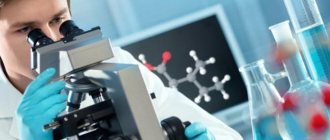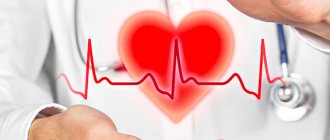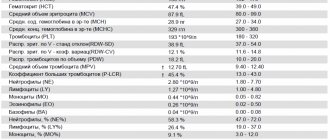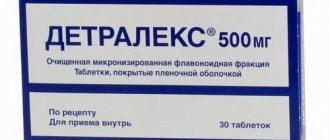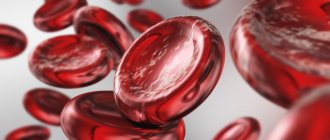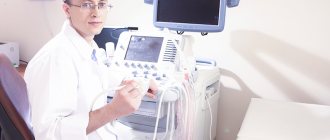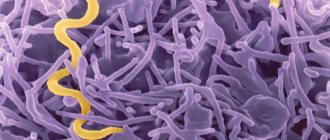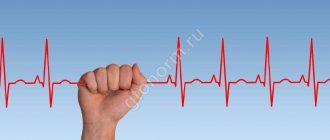Author
Pikulik Natalya Sergeevna
Leading doctor
Cardiologist
until January 31
You get 10% cashback when purchasing a gift certificate More details All promotions
Electrocardiography
(ECG) is a study of the electrical activity of the heart. An ECG is a non-invasive diagnostic procedure carried out using sensors attached to the patient's chest, during which the bioelectric potentials arising during operation are recorded. The results are recorded on a special tape recorder or in digital form. The document with the results of the study is called a cardiogram (electrocardiogram). An ECG, that is, an electrocardiogram, is necessary for any suspicion of heart problems. An ECG is a diagnostic minimum that forms the foundation of cardiac examination and treatment.
Why does an ECG help us judge the condition of the heart?
ECG
The human heart is essentially a pump that keeps blood moving. To do this, the heart muscle either contracts or relaxes. The rate of contraction of the heart forms the heart rhythm. A healthy heart contracts at regular intervals, and the duration of this interval should also fall within the norm, which depends on age. A normal resting heart rate usually ranges from 60 to 100 beats per minute. In children under 12 years of age, higher values will be normal (for example, under the age of 1 year, the average value is 130 beats per minute). With age, the heart rate slows down: in older people, the normal heart rate is 60-65 beats per minute.
The contraction of the heart muscle is regulated by electrical impulses generated in the heart itself. The main role belongs to a group of cells that form the so-called sinus node, located in the right atrium. It is he who generates impulses that normally set the contraction of the heart. In this case, the bioelectric mechanism of the heart is designed in such a way that the muscles of the atria contract almost simultaneously, pushing blood into the ventricles of the heart, and the muscles of the ventricles also contract simultaneously, but with a delay relative to the atria of about one tenth of a second. This time is necessary for the ventricles to fill with blood. Any violation of this complex and precise mechanism of generation and propagation of electrical impulses leads to disturbances in the functioning of the heart, manifested in the form of symptoms of heart disease. Conversely, heart pathology affects the accuracy of the bioelectric mechanism. Therefore, when symptoms of heart disease occur, first of all, an ECG is done.
Last news
Happy Victory Day!
Let it never be forgotten what an ordinary person did during the war. Soldier, peasant, youth and boy. They believed so strongly in luck, in the country, in themselves, and they knew for sure that they would not give Russia up to anyone. Let the fireworks fly up on this day, let the songs of those distant years be sung today. Happy Victory Day!
“Healthcare Week in the Republic of Bashkortostan” We invite you to visit and take part in the V Medical Forum-Exhibition “Healthcare Week in the Republic of Bashkortostan” from April 7 to April 10, 2021 in Ufa, at the VDNH-EXPO exhibition complex.
“Possibilities of cancer prevention and complementary methods in oncology” March 20-22 - an unprecedented event!! II annual Conference “PreventAge-medicine - the crossroads of 7 roads” “Modern opportunities and prospects for cancer prevention and complementary methods in oncology”
Conference We invite you to take part in the next event that continues the educational traditions of the Kazan School of Orthopedic Traumatologists.
Anniversary of the City Center for Endoscopic Urology As part of the conference, about 30 surgical interventions on most pathologies of the human urinary system will be broadcast in parallel on three screens in 3D.
XII International Symposium on Sports Medicine XII International Symposium on Sports Medicine and Rehabilitation under the auspices of the First Moscow State Medical University named after. THEM. Sechenov. October 19-20, Moscow. Two days, more than 30 reports, master classes, exhibition exposition.
Information content and diagnostic capabilities of ECG
An ECG can reveal:
- heart rhythm disturbances (diagnosis of various types of tachycardia, as well as atrial fibrillation, parasystole and other types of heart rhythm disturbances);
- cardiac conduction disorders. This leads to a shift in the generation of impulses from the sinus node, as well as to its blockade in any part of the heart;
- decrease in coronary circulation in one or another part of the heart (coronary heart disease);
- focal changes in the heart (scar tissue formed after inflammatory diseases, myocardial infarction and other diseases);
- myocardial hypertrophy (thickening of the myocardial walls).
Reading a cardiogram
How to decipher a cardiogram of the heart? This question is asked by many patients who have had to deal with the electrocardiography procedure. It is very difficult to do this yourself, because decrypting data has a lot of nuances. And if you read certain disturbances in the activity of the heart in your cardiogram, this does not at all mean the presence of this or that disease.
A cardiologist reads a cardiogram
Prongs
In addition to taking into account intervals and segments, it is important to monitor the height and duration of all teeth. If their fluctuations do not deviate from the norm, this indicates healthy functioning of the heart. If the amplitude is deviated, we are talking about pathological conditions.
Norm of waves on an ECG:
- P – should have a duration of no more than 0.11 s., a height within 2 mm. If these indicators are violated, the doctor can make a conclusion about a deviation from the norm;
- Q – should not be higher than a quarter of the R wave, wider than 0.04 s. Particular attention should be paid to this tooth; its deepening often indicates the development of myocardial infarction in a person. In some cases, tooth distortion occurs in people with severe obesity;
- R – when deciphered, it can be traced in leads V5 and V6, its height should not exceed 2.6 mV;
- S is a special tooth for which there are no clear requirements. Its depth depends on many factors, for example, weight, gender, age, body position of the patient, but when the tooth is too deep, we can talk about ventricular hypertrophy;
- T – must be at least a seventh of the R wave.
In some patients, after the T wave on the cardiogram, a U wave appears. This indicator is rarely taken into account when making a diagnosis and does not have any clear standards.
Segments and Intervals
Intervals and segments also have their own normal values. If these values are violated, the specialist usually gives a referral to the person for further research.
Normal indicators:
- The ST segment should normally be located directly on the isoline;
- The QRS complex should not last more than 0.07 - 0.11 s. If these indicators are violated, various pathologies of the heart are usually diagnosed;
- the PQ interval should last from 0.12 milliseconds to 0.21 seconds;
- The QT interval is calculated taking into account the heart rate of a particular patient.
Segments and Intervals
Important! The ST segment in leads V1 and V2 sometimes runs slightly above the baseline. The specialist must take this feature into account when deciphering the ECG.
Indications for ECG
ECG is performed:
- for any diseases of the cardiovascular system;
- if you suspect such diseases, for example, chest pain, shortness of breath, swelling of the legs;
- people who are at risk of developing heart disease (those with a hereditary predisposition, those suffering from obesity, atherosclerosis, bad habits - smoking, alcoholism) to determine the condition of the heart;
- in case of risk of complications from the heart, in particular with hypertension, after infectious diseases (for example, tonsillitis), after a stroke;
- when planning and managing pregnancy;
- to assess the effect of medications on the body (in particular, to confirm the absence of side effects when taking them);
- to check the operation of pacemakers.
Who should not conduct
There are absolute and relative contraindications to performing ECG stress tests.
Absolute:
- the first 2 days of acute myocardial infarction;
- unstable heartbeat without prior drug treatment;
- pronounced signs of aortic stenosis;
- acute pulmonary embolism;
- acute pericarditis and myocarditis;
- dissecting aortic aneurysm, occurring in an acute form.
Relative:
- aneurysm of blood vessels or heart;
- hypertension with systolic blood pressure above 200 and diastolic blood pressure above 110 mmHg. Art.;
- tachyarrhythmia of unknown origin;
- bradyarrhythmia with pronounced symptoms;
- heart block;
- hypertrophic cardiomyopathy;
- severe heart rhythm problems, fainting;
- mental or physical disorders that prevent adequate physical activity;
- electrolyte disturbances;
- joint diseases;
- severe anemia;
- endocrine diseases;
- severe obesity.
Testing is not recommended in case of fever, acute thrombophlebitis, or recent stroke. However, relative contraindications are neglected if the significance of the diagnostic results outweighs the risks.
During the procedure, the patient is constantly under the supervision of a specialist. If during the examination a severe arrhythmia, sharp chest pain, increased blood pressure, dizziness, darkening of the eyes occur, or your health deteriorates significantly, the testing is stopped immediately.
How is an ECG done?
The ECG procedure is simple and does not cause significant discomfort. To take an electrocardiogram you will need to lie down on a couch. Electrodes are attached to the chest, legs and arms and connected to an ECG machine.
Usually you need to lie still for 5-10 minutes, maintaining a natural breathing rhythm. In some cases, the doctor may ask you to hold your breath.
You can have an ECG done at any of the Family Doctor clinics.
Sometimes more data is needed to evaluate your heart condition. In this case, 24-hour (Holter) ECG monitoring may be suggested. The information will be collected by a portable device that will need to be worn throughout the day. This will allow you to obtain data on the work of the heart in everyday life.
Sign up for diagnostics Do not self-medicate. Contact our specialists who will correctly diagnose and prescribe treatment.
Influencing factors
Although the ECG technique has a fairly clear algorithm, some errors cannot be ruled out.
- The appearance of interference from inrush currents of the electrical network (irregular oscillations with a frequency of 50 Hz).
- Fluctuations caused by poor contact of the electrode with the skin.
- Record muscle tremors if the patient is anxious or cold.
- Incorrect application of electrodes. Mostly, the electrodes on the upper limbs are swapped and signals of unusual polarity are received.
- Record additional leads without switching the recorder from enhanced leads to lead V.
- Failure to insert a roll of thermal tape into the device, as a result of which the drawing mechanism can slow down and affect the width of the recorded complexes.
Fixation of electrodes in chest leads
If a single-channel study is carried out, then only one electrode is used. But in modern ECGs, for more accurate diagnosis, in most cases, 6 are used. They are designated by the Latin letter V and are superimposed at the following points:
- V1 - at the right edge of the sternum in the 4th intercostal space, the red wire is connected;
- V2 - also in the 4th intercostal space, but on the left edge of the sternum, wire color - yellow;
- V3 - in the middle between the 4th and 5th intercostal spaces along the left line, connect the green cable;
- V4 - along the midclavicular line in the 5th intercostal space, wire color - brown;
- V5 - along the anterior axillary line in the 5th intercostal space, connected to a black cable;
- V6 - in the middle of the axillary line at the same level with V450m, the wire color is blue (possibly purple).
